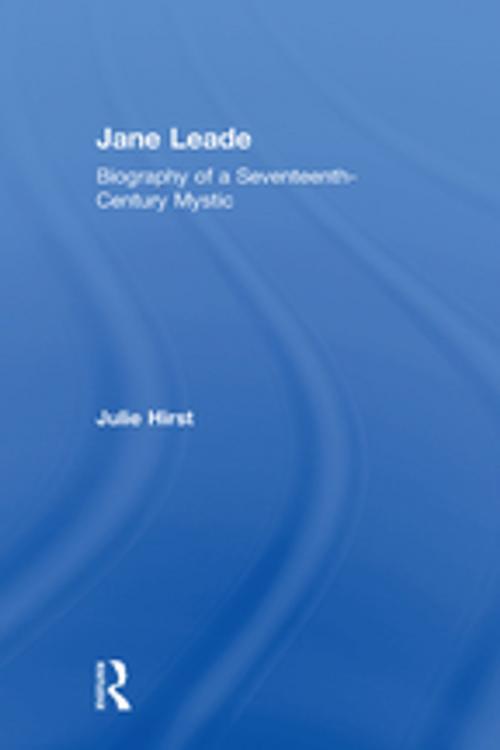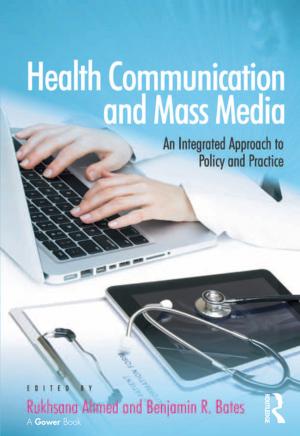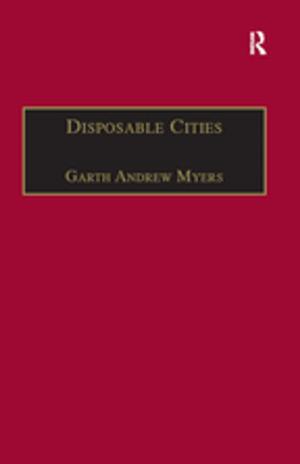| Author: | Julie Hirst | ISBN: | 9781351925600 |
| Publisher: | Taylor and Francis | Publication: | September 8, 2017 |
| Imprint: | Routledge | Language: | English |
| Author: | Julie Hirst |
| ISBN: | 9781351925600 |
| Publisher: | Taylor and Francis |
| Publication: | September 8, 2017 |
| Imprint: | Routledge |
| Language: | English |
Jane Leade (1624-1704) is probably the most prolific woman writer and most important female religious leader in late seventeenth-century England, yet, she still remains relatively unknown. By exploring her life and works as a prophetess and mystic, this books opens a fascinating window into the world of a remarkable woman living in a remarkable age. Born in Norfolk into a gentry family, Jane Leade enjoyed a comfortable childhood, married a distant cousin, who was a merchant, and had four children. However, she found herself totally destitute in London when he died, his fortune having been lost abroad. As a widow, she proclaimed herself to be a `Bride of Christ', and eventually became a prolific author and a respected blind, elderly leader of a religious group of well-educated men and women, known as the Philadelphian Society. The structure of this book is informed by the chronological events that happened during her life and is complemented by examining some of the material she published, including her visions of the Virgin Wisdom, or Sophia. She started writing in 1670, but published prolifically in the 1680s and 1690s, and this material offers a fascinating glimpse into the mind of an extraordinary woman. Believing herself to be living in the `End Times' she expected Sophia would return with the second coming of Christ. The Philadelphian Society grew under her charge, until they were buffeted by mobs in London. Jane Leade died in her eighty-first year and is buried in the non-conformist cemetery, Bunhill Fields, in London. By contextualising her and drawing out the nature of her devotions this new book draws attention to her as a figure in her own right. Previous studies have tended to reduce her to one example within a certain tradition, but as this work clearly demonstrates she was in fact a much more complicated character who did not conform to any one particular tradition.
Jane Leade (1624-1704) is probably the most prolific woman writer and most important female religious leader in late seventeenth-century England, yet, she still remains relatively unknown. By exploring her life and works as a prophetess and mystic, this books opens a fascinating window into the world of a remarkable woman living in a remarkable age. Born in Norfolk into a gentry family, Jane Leade enjoyed a comfortable childhood, married a distant cousin, who was a merchant, and had four children. However, she found herself totally destitute in London when he died, his fortune having been lost abroad. As a widow, she proclaimed herself to be a `Bride of Christ', and eventually became a prolific author and a respected blind, elderly leader of a religious group of well-educated men and women, known as the Philadelphian Society. The structure of this book is informed by the chronological events that happened during her life and is complemented by examining some of the material she published, including her visions of the Virgin Wisdom, or Sophia. She started writing in 1670, but published prolifically in the 1680s and 1690s, and this material offers a fascinating glimpse into the mind of an extraordinary woman. Believing herself to be living in the `End Times' she expected Sophia would return with the second coming of Christ. The Philadelphian Society grew under her charge, until they were buffeted by mobs in London. Jane Leade died in her eighty-first year and is buried in the non-conformist cemetery, Bunhill Fields, in London. By contextualising her and drawing out the nature of her devotions this new book draws attention to her as a figure in her own right. Previous studies have tended to reduce her to one example within a certain tradition, but as this work clearly demonstrates she was in fact a much more complicated character who did not conform to any one particular tradition.















